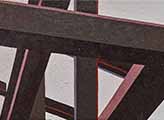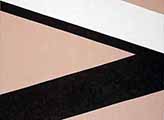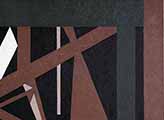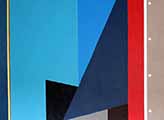
New Works by Roger Winter
May 25-July 13, 2019
Opening reception Saturday, May 25, 6:00-8:00 pm
Artist in attendance
Viewing Room
In advance of the major publication Roger Winter: Fire And Ice, forthcoming from Texas A&M University Press, KHFA is pleased to present a selection of works from the artist's recent "Construction Site" series. For years, Winter has aimed to condense his painting by reducing it to essentials. After experiencing Iceland's limitless horizontal planes and startlingly pure light, the artist was inspired to view the structures of Manhattan through an increasingly reductive lens.
Like the 1930s Precisionist artists Charles Sheeler, George Ault, Niles Spencer and, especially, Ralston Crawford, who portrayed factories and mechanical structures using a sharp-edged, simplified and precise technique, Winter also focuses on architectural and industrial themes characterized by a carefully reasoned abstraction in which subjects are streamlined to their basic, geometric shapes. Whereas the Precisionists pursued an art marked by a nonpainterly handling of color and images brought to a flatly defined finish, Winter's solid overlapping of shapes are lit from within. His abstract patchworks are at once in motion and meticulously puzzled together, seemingly both topographical and tapestry-like with the deliberate touch of every stroke.
Rendered in luminous tonalities, Winter's "Construction Site" paintings describe complex spaces by way of perspective grids and raking diagonals set in fully volumetric counterpoint to one another. The overlapping shapes, the harmonious and dissonant mix of colors and the deep shadows created by strong light emphasize the rich, visual geometries of Manhattan, if not the very beat of the city.
As Winter knows, to live in a city as changeable as New York is to live in a place that is always on the cusp of disappearing or being replaced by some new version of itself. "In the past, I have painted New York City from several viewpoints—from the interaction of people and buildings and statues in Union Square to window displays and subway riders," says Winter. "But at this time in life, I'm far more interested in the city's geometry. Whether in the heavy beams at a building site, the doors and windows in the cliff dwellings where we work, the steps leading down to a brownstone basement, or the horizontal planes of the sidewalks and rooftops, I live in a geometric world."
For the "Construction Site" series, Winter focuses on Manhattan's forgotten corners, mostly places and architectural underpinnings that could pass as inconsequential. It's important to note that although Winter's forms are relatively hard-edged, they are not obsessively labored. There is no underpainting and he does not use masking tape as a production tool. All of these paintings pursue the challenge of analyzing the city forms as geometrized environments of illusory space, angular shapes and sharp silhouettes.
Construction Work with Five Dots features a section of blue wall, strip of red signage and row of "bolts" that hold the fencing in place. Substructure is a scheme of deft switchbacks that smoothly couples a pictorial depiction of shifting depths to an abstract composition of planar forms. For Reflection, Winter renders the shapes of a construction site as mirrored by the glare in a window's glass. Here, he sets us teetering on the fulcrum between material and imaginary worlds. Winter's explorations of ordinary building zones that hide in plain sight trigger rushes of wonderment. His perceptual eccentricities and search for beauty in mundane subjects indulge the dumbfounded surprise that hits us when we stop, forget ourselves, and just look around.
—Susie Kalil
Roger Winter, born in Denison, Texas, currently lives and works in New York. He holds a BFA from the University of Texas at Austin and a MFA from the University of Iowa in Iowa City. He returned to Texas in 1961 where he taught drawing and painting at Southern Methodist University for twenty-six years. Winter's exhibition history has included museums and galleries nationwide and his work is currently in the collections of the Atlantic Richfield Company in Los Angeles, Dallas Museum of Art, El Paso Museum of Art, Federal Reserve Bank of Dallas, Frito-Lay Corporate Collection, Meadows Museum of Art, McNay Museum, Museum of Fine Arts, Houston, Portland Museum of Art in Maine, and Southwestern Bell Corporation, among others.








